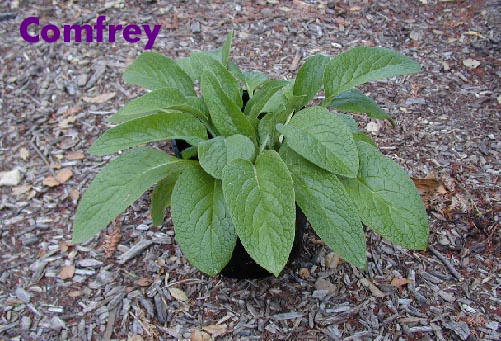Comfrey
[size=75]From Wikipedia, the free encyclopedia [/size]
For the place, see Comfrey, Minnesota
Comfrey (also comphrey) is an important herb in organic gardening, having many medicinal and fertilizer uses.
Comfrey (Symphytum officinale L.) is a perennial herb of the family Boraginaceae with a black, turnip-like root and large, hairy broad leaves that bears small bell-shaped white, cream, purple or pink flowers. It is native to Europe, growing in damp, grassy places, and is widespread throughout the British Isles on river banks and ditches. Comfrey has long been recognised by both organic gardeners and herbalists for its great usefulness and versatility; of particular interest is the “Bocking 14” cultivar of Russian Comfrey (Symphytum x uplandicum). This strain was developed during the 1950s by Lawrence D Hills, the founder of the Henry Doubleday Research Association (the organic gardening organisation itself named after the Quaker pioneer who first introduced Russian Comfrey into Britain in the 1910s) following trials at Bocking, near Braintree, the original home of the organisation.
Other species include:
Bocking 14 is sterile, and therefore will not set seed (one of its advantages over other cultivars as it will not spread out of control), thus is propagated from root cuttings. The gardener can produce their own ‘offsets’ from mature, strongly growing plants by driving a spade horizontally through the leaf clumps about 3 inches below the soil surface. This removes the crown which can then be split into pieces. The original plant will quickly recover, and each piece can be replanted with the growing points just below the soil surface, and will quickly grow into new plants. When choosing plants to divide ensure that they are strong healthy specimens with no signs of rust or mildew. When dividing comfrey plants take care not to spread root fragments around, or dispose of on the compost heap as each can re-root, and comfrey can be a very difficult plant to get rid of. Offsets can also be purchased by mail order from specialist nurseries in order to initially build up a stock of plants.
The comfrey bed should be well prepared by weeding thoroughly, and dressing with manure if available. Offsets should be planted 2-3 feet apart with the growing points just below the surface, whilst root segments should be buried about 2 inches deep. Keep the bed well watered until the young plants are established. Comfrey should not be harvested in its first season as it needs to become established. Any flowering stems should be removed as these will weaken the plants in its first year. Comfrey should also be regularly watered until well established.

